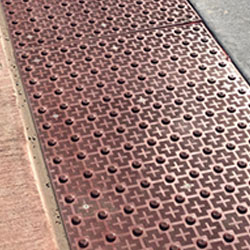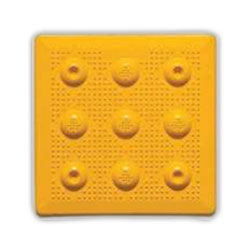

































































































































The landscape for accessibility and inclusion is rapidly evolving in Canada. With several landmark regulations like the Accessibility for Ontarians with Disabilities Act (AODA) already in place, a major milestone is set to arrive in 2025 that will impact federal accessibility standards nationwide.
This upcoming deadline pertains to the Accessible Canada Act (ACA), the ambitious federal law that seeks to make Canada barrier-free by 2040. By June 1, 2025, all federally regulated public and private sector organizations with ten or more employees must comply with the ACA’s first phase of accessibility regulations.
This deadline carries major implications for contractors, architects, and construction companies involved in building and renovating public spaces. The ACA mandates extensive accessibility upgrades to buildings, transportation, urban design, communications technology, and, crucially, code compliant tactile solutions for walking surfaces.
This means integrating code-compliant tactile walking surface indicators and guidance systems will become a legal obligation for making public realm spaces accessible under the ACA.
As Canada’s leading tactile solutions provider, Tactile Solution Canada is the ideal partner for contractors seeking expert guidance on selecting and installing ACA-compliant tactile systems ahead of the 2025 deadline.
This blog covers what Canadian builders need about tactile surface compliance under upcoming ACA regulations.
The Accessible Canada Act (ACA) became law in 2019 and is among the most progressive federal accessibility legislations globally. The ACA aims to achieve a “barrier-free Canada” by 2040.
The law defines a “barrier” as anything hindering the full participation of people with disabilities in society. The ACA takes an expansive view of accessibility, going beyond the built environment to address barriers to accessibility in:
Employment
Transportation
Procurement of goods, services and facilities
Built environment
Information and communication technologies
Communication
Delivery of programs and services
This broad scope encompasses both physical and digital aspects of accessibility. The ACA empowers the Canadian Radio-television and Telecommunications Commission (CRTC) and the Canadian Transportation Agency to develop binding accessibility regulations and codes in phases targeted for 2025, 2030, and ultimately 2040.
These regulations will impose significant accessibility upgrades to federally regulated workplaces, buildings, transportation networks, pedestrian infrastructure, communications technology, and media.
Of particular relevance for Canadian contractors and builders are the regulations under the ACA mandating enhanced accessibility in pedestrian walking surfaces and the built environment.
The ACA requires upgrading outdoor and indoor pedestrian circulation routes, corridors, floors, stairs, elevators, escalators, doors, wayfinding systems, and other architectural features to remove mobility barriers.
A key focus area is installing standardized tactile walking surface indicators (TWSIs) on pedestrian circulation paths, both indoors and outdoors. TWSIs, called tactile attention or guidance indicators, are textured ground surface markers that provide vital orientation cues and warnings of potential hazards to users through their feet or mobility canes.
The ACA mandates installing compliant tactile attention and guidance systems across all new, extensively renovated public buildings and spaces. This will enable millions of Canadians with vision loss or mobility disabilities to navigate the built environment safely and seamlessly.
All new and upgraded pedestrian walking surfaces must integrate compliant tactile attention and guidance indicators as per the upcoming enforceable CRTC regulations modeled after current standards like:
CSA B651: Sets technical specifications for tactile walking surface indicators in Canada
ISO 23599: International tactile walking surface standard
This requires understanding optimal materials, textures, dome/bar sizing, beveling, visual contrast, installation methods, and placement locations.
The ACA requires involving people with disabilities when planning and implementing accessibility upgrades. Their input on preferences and needs is invaluable for choosing suitable tactile systems.
Proper tactile installation as per codes demands trained professionals. Staff needs instruction on surface prep, layout, application, setting, orientation, and beveling to optimize tactile functionality.
User testing by people with vision disabilities is essential to ensure the installed tactile solutions enhance accessibility as intended. User feedback needs to inform modifications.
Keep installed tactile surfaces compliant over the years via scheduled inspections, damage repair, replacements, and preservation of visual contrast.
Following these best practices and the CRTC regulations will allow builders to integrate the optimal ACA-compliant tactile solutions in their projects.
Tactile Solution Canada supplies the most comprehensive range of tactile walking surface indicators from leading brands like Armor Tile, Access Tile, and Advantage Tile.
Our world-class tactile systems enable ACA compliance by providing the following:
Rigorous load testing for heavy footfall
Durability against harsh Canadian weather extremes
Standards compliance with CSA, ISO, AODA
Customization to specification needs
Easy installation and replacement
Extensive safety certifications
With over a decade of supplying tactile solutions for accessibility projects, our experts will recommend the ideal systems to suit your public space requirements.
By consulting us early in your project design process, we can ensure the integration of optimal ACA-compliant tactile walking surfaces to make infrastructure accessible for all.
The ACA requires installing compliant tactile attention and guidance tiles on pedestrian circulation paths in new and upgraded public buildings and spaces. This enables accessibility for people with vision disabilities.
Benefits include enhanced mobility for blind and low-vision users, hazard warnings, clear wayfinding, safety for all pedestrians, meeting code compliance, and inclusive, accessible design.
What areas need tactile tiles?
Building entrances: Mark doorway thresholds
Lobbies and atriums: Direct to key areas like reception
Retail aisles: Help navigate large open floors
Transit stations: Guide to platforms, Information kiosks, ticket areas
Corridors: Define walkways in expansive spaces
Sidewalk curb ramps: Alert to transition from sidewalk to street
Transit platforms: Warn of platform edge drop-off
Pedestrian crossings: Mark the crosswalk area on the road surface
Stairways and ramps: Indicate change in level
Parks and plazas: Guide across open spaces
The ACA applies to federally regulated public and private sector organizations in Canada with 10+ employees. This includes contractors involved in building and renovating public spaces.
Follow manufacturer specifications, use trained installers, test surface effectiveness post-installation, and develop maintenance plans to preserve functionality.
Achieving full ACA accessibility compliance across Canada’s vast public infrastructure by 2040 will require considerable collective effort. For contractors charged with upgrading public buildings and spaces, integrating code-compliant tactile walking surfaces is an essential piece of this mission.
As Canada’s premier tactile surface experts, Tactile Solution Canada is ready to assist. Our advisors can prescribe the ideal tactile warning systems to make your upcoming projects inviting and safe spaces for all citizens, regardless of ability.
Let us help pave the path to a truly accessible Canada. Contact Tactile Solutions Canada today!
